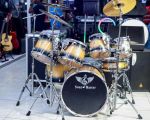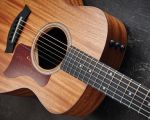Top Acoustic Guitars for Fingerstyle Playing: A Personal Guide
As a passionate guitarist who loves fingerstyle playing, I've spent countless hours researching, testing, and playing various acoustic guitars to find the perfect match for this unique style. Fingerstyle guitar playing allows you to incorporate melody, harmony, and rhythm all at once, making it one of the most expressive forms of playing. But to truly bring out the best of this technique, you need a guitar that complements the intricacy and subtlety of your playing. In this article, I'll share my top picks for acoustic guitars that are perfect for fingerstyle, providing you with insights into their features, sound, and why they work so well for fingerpicking. Whether you're a beginner or an experienced player, you'll find something that suits your needs and preferences.
1. What Makes a Guitar Great for Fingerstyle Playing?
Before diving into the specifics of my top picks, it's important to understand what characteristics make a guitar ideal for fingerstyle. Fingerstyle guitar playing involves using the fingers and thumb to pluck the strings rather than using a pick, which gives it a more delicate and nuanced sound. The right guitar for this technique should have a balanced tone, clear definition, and the ability to produce both warm, rich lows and sparkling highs.
1.1. Tonewoods and Construction
When choosing a guitar for fingerstyle, the materials used in its construction play a significant role in its tonal characteristics. Solid wood tops (like spruce or cedar) offer a more responsive and dynamic sound, while the body wood (such as mahogany or rosewood) contributes to the warmth and sustain. The shape and size of the guitar also matter; smaller-bodied guitars tend to have a more focused sound, while larger guitars provide more resonance and depth.
1.2. Playability and Comfort
Fingerstyle playing demands comfort and ease of playability. A smooth, comfortable neck and action that isn’t too high or low are essential for effortless finger movements. A cutaway design can also help with easier access to higher frets, which is useful for those intricate melodies often found in fingerstyle playing.
2. My Top Picks for Fingerstyle Acoustic Guitars
Based on my experience with various guitars, here are my top picks for acoustic guitars that excel in fingerstyle playing. Each of these guitars offers a unique blend of tone, playability, and aesthetics that I believe will elevate your playing to the next level.
2.1. Martin 000-15M
The Martin 000-15M is an absolute favorite of mine for fingerstyle playing. It has a solid mahogany body that delivers a warm, rich tone with plenty of midrange punch, perfect for fingerpicking. The smaller 000 body size makes it incredibly comfortable to play, and the guitar’s overall balance makes it sound fantastic whether you're playing soft, intricate passages or slightly more aggressive fingerstyle techniques.
The 000-15M has a relatively simple, understated design, which gives it a vintage feel. The solid mahogany top, back, and sides offer a mellow tone, with excellent clarity in the higher frequencies, which is ideal for picking out individual notes in complex fingerstyle patterns. The action is just right for me, providing great comfort and playability for long practice sessions.
2.2. Taylor 314ce
The Taylor 314ce is another fantastic choice for fingerstyle guitarists. Known for its bright, clear tone, the Taylor 314ce has a solid spruce top and layered rosewood back and sides, which give it a strong projection and a crisp, articulate sound. This guitar is ideal for those who want to bring out the nuances of their fingerstyle technique, as the clarity of the individual strings really stands out.
One of the standout features of the Taylor 314ce is its Expression System 2 (ES2) pickup, which ensures that the guitar’s natural tone is captured beautifully when amplified. While I primarily play acoustically, the option to plug in and perform live without losing the guitar’s tonal integrity is a great bonus for those who perform regularly.
2.3. Guild OM-240E
If you're looking for a more affordable option that still delivers excellent tone for fingerstyle playing, the Guild OM-240E is a great choice. The orchestra model (OM) body is slightly smaller than a dreadnought, making it perfect for fingerpicking as it produces a focused, balanced sound with good clarity. The solid spruce top and mahogany back and sides deliver a warm tone with bright, ringing highs and smooth lows.
One of the reasons I love the Guild OM-240E for fingerstyle is the neck. The slim profile makes it easy to navigate, and the action is just perfect for fingerpicking. It also has a built-in pickup system, so it’s great for gigging musicians. For the price, it offers incredible value, especially for beginner to intermediate players.
2.4. Larrivée Parlor Acoustic Guitar
The Larrivée Parlor acoustic guitar is a wonderful choice for fingerstyle players who enjoy a more vintage sound. This smaller-bodied guitar features a solid spruce top and solid mahogany back and sides, creating a rich, complex tone with plenty of sustain. The parlor size is particularly suited for fingerstyle playing because of its focused, bright sound, which is perfect for delicate, intricate picking.
The build quality of the Larrivée Parlor is exceptional. The guitar has a comfortable neck and low action, which makes it an easy guitar to play for extended periods. Whether you're playing soft melodies or more energetic fingerpicking patterns, this guitar’s tone and responsiveness are sure to satisfy.
2.5. Seagull S6 Original
For those on a budget but still looking for a high-quality acoustic for fingerstyle, the Seagull S6 Original is a top contender. This guitar has a solid cedar top and wild cherry back and sides, which creates a warm, well-balanced tone with plenty of articulation. The Seagull S6 is often praised for its incredible value, and I’ve found it to be an excellent option for fingerstyle players who need a guitar that can produce clear, distinct notes without breaking the bank.
The Seagull S6 is known for its great craftsmanship and durability, and its smooth, comfortable neck is ideal for easy fingerpicking. While it may not have the high-end bells and whistles of other models, it offers a fantastic tone and feel at a fraction of the cost. It’s a solid option for beginner to intermediate fingerstyle guitarists who are looking for something that’s both affordable and high-quality.
3. Factors to Consider When Choosing a Guitar for Fingerstyle
When choosing an acoustic guitar for fingerstyle playing, there are several factors to keep in mind that will affect the sound and playability. Here’s a breakdown of the most important aspects to consider:
3.1. Body Size
The size of the guitar’s body will affect how much resonance and projection it has. Smaller-bodied guitars like parlor and concert models are great for fingerstyle because they produce a more focused sound, which is ideal for picking out individual notes. However, larger guitars like dreadnoughts offer more volume and sustain, which might be preferred if you’re looking for a fuller sound.
3.2. Tonewoods
The tonewoods used in the construction of the guitar play a crucial role in its sound. As mentioned earlier, solid spruce and cedar tops are great for fingerstyle, as they provide a balanced tone with great response. The back and sides, often made from mahogany, rosewood, or maple, contribute to the warmth, clarity, and depth of the sound. Pay attention to the combination of woods to get the tone that best suits your style of playing.
3.3. Neck Profile and Action
Fingerstyle playing requires precision, so it’s important that the guitar’s neck is comfortable and easy to navigate. A slim neck profile and low action will help you play with greater ease and fluidity. Always make sure that the action is set up well, as this can affect the clarity of the notes and your overall playing experience.
4. Conclusion
Finding the perfect acoustic guitar for fingerstyle playing can take time, but it’s worth the effort to find one that suits your playing style and sound preferences. Whether you opt for the warm tones of a Martin 000-15M or the bright clarity of a Taylor 314ce, there’s an acoustic guitar out there that will help you bring out the best in your fingerpicking technique. I hope this guide has helped you understand what to look for in a guitar for fingerstyle playing, and I encourage you to explore the options mentioned here. Happy playing!








